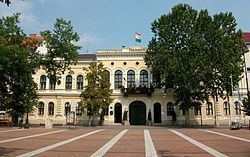Elevation 89 m (292 ft) Postal code 5600 Area 193.9 km² Number of airports 1 | Time zone CET (UTC+1) Website www.bekescsaba.hu Area code 66 | |
 | ||
Clubs and Teams Békéscsaba 1912 Előre, Békéscsabai Előre NKSE | ||
Békéscsaba ([ˈbeːkeːʃt͡ʃɒbɒ]; see also other alternative names) is a city in Southeast Hungary, the capital of the county Békés.
Contents
- Map of BC3A9kC3A9scsaba Hungary
- Geography
- Name
- History
- Languages
- Ethnic groups
- Religion
- Tourist sights
- Politics
- Born in Bkscsaba
- Lived in Bkscsaba
- Died in Bkscsaba
- Twin towns Sister cities
- References
Map of B%C3%A9k%C3%A9scsaba, Hungary
Geography
Békéscsaba is located in the Great Hungarian Plain, 215 km (134 mi) southeast from Budapest. Highway 44, 47, Békéscsaba beltway (around the city) and Budapest-Szolnok-Békéscsaba-Lökösháza high speed (120–160 km/h (75–99 mph)) railway line also cross the city. Highway 44 is a four-lane expressway between Békéscsaba and Gyula. According to the 2011 census, the city has a total area of 193.93 km2 (75 sq mi).
Name
Csaba is popular Hungarian given name for boys of Turkic origin, while prefix Békés refers to the county name Békés, which means peaceful in Hungarian. Other names derived from the Hungarian one (German: Tschabe, Romanian: Bichișciaba, Slovak: Békešská Čaba).
History
The area has been inhabited since the ancient times. In the Iron Age the area had been conquered by the Scythians, by the Celts, then by the Huns. After the Hungarian Conquest, there were many small villages in the area.
The medieval Hungarian village of Csaba was established in the 13th century, first mentioned in the 1330s. Besides Csaba, eight other villages stood where now the town stands. According to the Hungarian Royal Treasury, Békéscsaba was an ethnic Hungarian settlement in 1495. When the Turks conquered the southern and central parts of Hungary, and these territories became part of the Ottoman Empire, the town survived, but it became extinct during the fights against the Turks in the 17th century.
In 1715, Csaba is mentioned as a deserted place, but only one year later its name can be found in a document mentioning the tax-paying towns. It is likely that the new Csaba was founded by János György Harruckern, who earned distinction in the liberation fights against the Ottoman Empire and bought the area of Békés county. In 1718, Harruckern invited Slovak settlers from Upper Hungary to the deserted area. By 1847, the town was among the twenty largest towns of Hungary, with a population of 22,000. Nevertheless, Csaba was still like a large village, with muddy streets and crowded houses.
By 1858, the railway line reached the town. This brought development; new houses and factories were built, the town began to prosper. Still, by the end of the 19th century the unemployment caused great tension, and in 1891 a revolt was oppressed by the help of Romanian soldiers. One of the most important person in the politics of the town was András L. Áchim, who founded a peasants' party and succeeded in having Békéscsaba elevated to the rank of "city with council".
World War I brought suffering to the town. Between 1919 and 1920, Békéscsaba was under Romanian occupation. After the Treaty of Trianon, Hungary lost its most important Southern cities, Arad and Oradea, and Békéscsaba had to take over their roles, becoming the most important town of the area. Hungarians overtook Slovaks in the 1920s, become the majority according to the census was held in 1930.
Between the two world wars the recession caused poverty and unemployment, and a flood in 1925 did not help either.
Battles were not fought in the area during World War II. However, several events occurred in the town in 1944: between 24 and 26 June 1944, over 3,000 Jews were sent to Auschwitz.
On 21 September 1944, the British and American Air Force bombed the railway station and its surroundings, killing more than 100 people. On 6 October 1944, the Soviet army occupied Békéscsaba.
During the Socialist times, Békéscsaba became the county seat of Békés (1950) and began to develop into one of the most important centres of food industry of Hungary. After the fall of the Communism in 1989, the industry nearly collapsed and many people lost their jobs. However, today the crisis seems to be over and Békéscsaba remained one of the most important centers of the Hungarian food industry.
Languages
According to the 2011 census, the total population of Békéscsaba were 62,050, of whom 61,912 people (99.8%) speak Hungarian, 10,140 (16.3%) English, 4,821 (7.8%) German, and 3,399 (5.5%) speak Slovak.
Ethnic groups
According to the 2011 census, there were 51,842 (83.5%) Hungarians, 1,881 (3%) Slovaks, 402 (0.6%) Roma, 293 (0.5%) Romanians, and 170 (0.3%) Germans in Békéscsaba. 9,666 people (15.6%) did not declare their ethnicity. In Hungary, people can declare more than one ethnicity, so other people declared Hungarian and a minority one together.
Religion
According to the 1869 census (first modern census in Hungary), Békéscsaba had 30,022 inhabitants, of whow there were 21,988 (73.2%) Lutheran, 5,880 (19.6%) Roman Catholic, 1,043 (3.5%) Jewish, 520 (1.7%) Orthodox, and 436 (1.4%) Hungarian Reformed (Calvinist).
The 1949 census showed 45,892 people, 25,661 (56.2%) Lutheran, 14,216 (31.1%) Roman Catholic, 4,750 (10.4%) Hungarian Reformed, and 498 (1.1%) Jewish.
In 2011, there were 10,694 (17.2%) Roman Catholic, 8,012 (12.9%) Lutheran, and 4,408 (7.1%) Hungarian Reformed in Békéscsaba. 19,650 people (31.7%) were irreligious and 1,027 (1.7%) Atheist, while 16,883 people (27.2%) did not declare their religion.
Tourist sights
Politics
The current mayor of Békéscsaba is Péter Szarvas (Independent).
The local Municipal Assembly has 17+1 members divided into this political parties and alliances:
Born in Békéscsaba
Lived in Békéscsaba
Died in Békéscsaba
Twin towns — Sister cities
Békéscsaba is twinned with:
